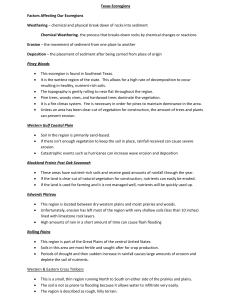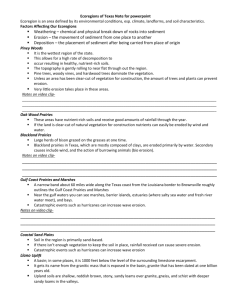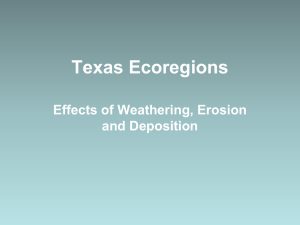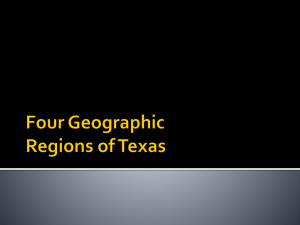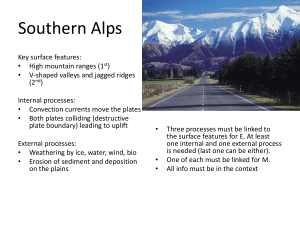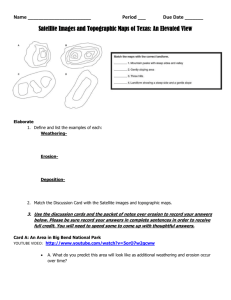File
advertisement
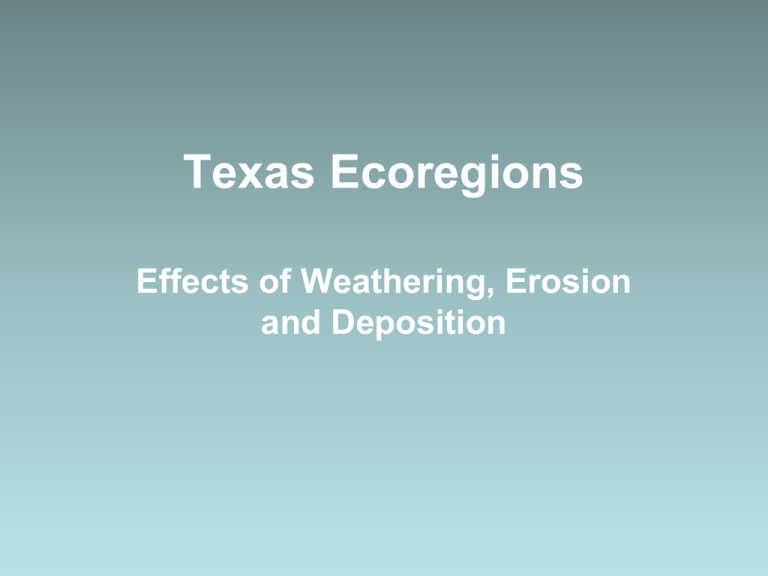
Texas Ecoregions Effects of Weathering, Erosion and Deposition I. Factors Affecting Our Ecoregions a. Weathering – chemical and physical break down of rocks into sediment b. Erosion – the movement of sediment from one place to another c. Deposition – the placement of sediment after being carried from place of origin d. CHEMICAL WEATHERING • THE PROCESS THAT BREAKS DOWN ROCKS BY CHEMICAL CHANGES OR REACTIONS. II. Texas Ecoregions Piney Woods i. This ecoregion is found in East Texas. ii. It is the wettest region of the state. This allows for a high rate of decomposition to occur resulting in healthy, nutrient-rich soils. iii. The topography is gently rolling to near flat through out the region. iv. Pine trees, woody vines, and hardwood trees dominate the vegetation. v. If a wildfire was to occur the positive effect would be that the pine trees can maintain dominance. vi. Negative effects would be loss of habitat and vegetation, vii. Unless an area has been clearcut of vegetation for construction, the amount of trees and plants can prevent erosion. Piney Woods Gulf Coast Prairies and Marshes Gulf Coast Prairies and Marshes i. Soil in the region is primarily sand-based. ii. If there isn’t enough vegetation to keep the soil in place, rainfall received can cause severe erosion. iii. Catastrophic events such as hurricanes can increase wave erosion and deposition. Blackland Prairie Blackland Prairie i. These areas have nutrientrich soils and receive good amounts of rainfall through the year. ii. If the land is clear-cut of natural vegetation for construction, nutrients can easily be eroded. iii. If the land is used for farming and it is not managed well, nutrients will be quickly used up. Edwards Plateau Edwards Plateau i. This region is located between dry western plains and moist prairies and woods. ii. Unfortunately, erosion has left most of the region with very shallow soils (less than 10 inches) lined with limestone rock layers. iii. High amounts of rain in a short amount of time can cause flash flooding. Rolling Plains Rolling Plains i. This region is part of the Great Plains of the North Central Texas. ii. Soils in this area are most fertile and sought after for crop production. iii. Periods of drought and then sudden increase in rainfall causes large amounts of erosion and deplete the soil of nutrients. Oak Woods and Prairies Oak Woods and Prairies i. This is a small, thin region running North to South on either side of the prairies and plains. ii. The soil is not as prone to flooding because it allows water to infiltrate very easily. iii. The region is described as rough, hilly terrain. High Plains High Plains i. “Texas Panhandle” ii. The region extends to the Palo Duro Canyonthe nation’s 2nd largest canyon. iii. Palo Duro Canyon was formed by water erosion from the Prairie Dog Town Fork of the Red River. iv. The water deepens the canyon by moving sediment downstream. v. Wind and water erosion gradually widen the canyon. South Texas Brush Country South Texas Brush Country i. The area is known as “Brush Country” due to the shorter trees and many shrubs. ii. Overgrazing of the land has allowed nutrientrich topsoil to erode way. iii. Rocky, dry soil cannot support grasses, trees can thrive because of their deeper root system. Trans-Pecos Trans-Pecos i. ii. iii. iv. v. vi. This area is found in West Texas. Rain does not fall evenly over the area. It is the “Desert portion” of Texas. The weathered bedrock in this area has high amounts of calcium. Soils are shallow and rocky. Weathering continues to play a role in developing soil and will for thousands of years to come. Soils in the canyon bottoms and valleys are deeper as a result of deposition. Coastal Sand Plain Coastal Sand Plain i. This region is found along the coastal shoreline. ii. It is composed of grasslands and coastal oak iii. It is the unstable, windblown sand that produces the characteristic dunes of this ecoregion Marine Environment Marine Environment i. This region runs along the Gulf Coast of Texas ii. It consists of salt water. iii. It is an ocean environment. iv. High tides and low tides continuously change the face of the Texas Coast line through erosion and deposition.
